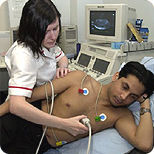
What is a cardiac arrest?
A cardiac arrest is also known as cardiopulmonary arrest or circulatory arrest.
It happens when the heart stops pumping blood around the body because of a disturbance in the normal heart rhythm.
The most common life threatening disturbance of the heart rhythm is called ventricular fibrillation.
